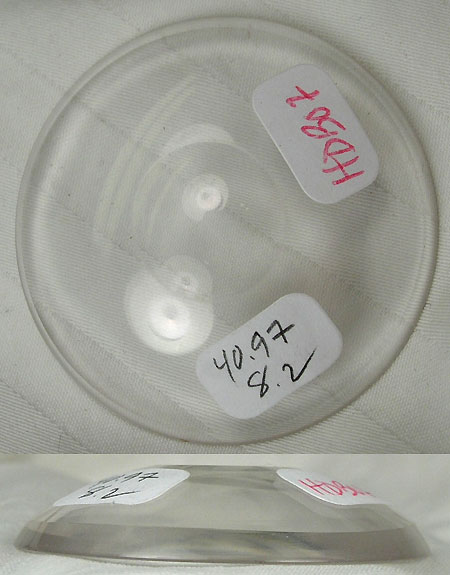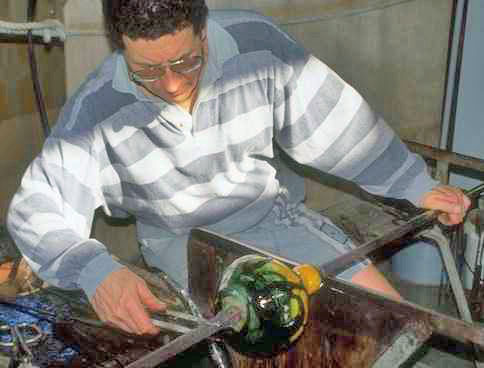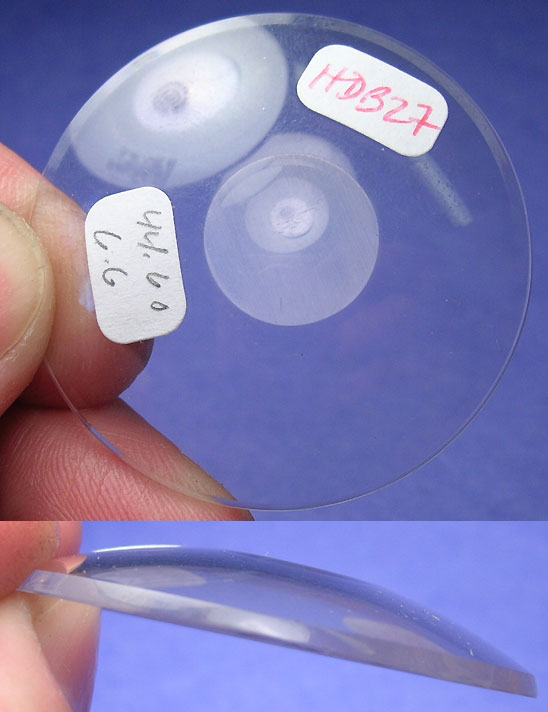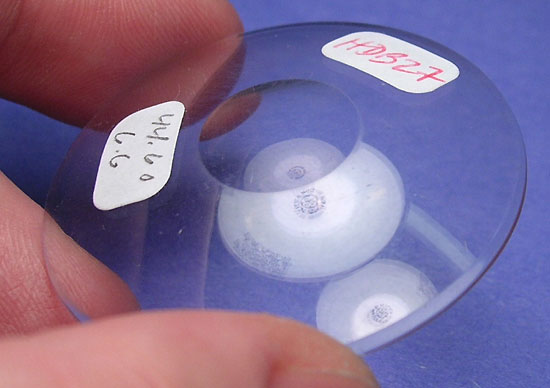
| WWT Shows | CLICK TO: Join and Support Internet Horology Club 185™ | IHC185™ Forums |

|
• Check Out Our... • • TWO Book Offer! • |
Welcome Aboard IHC185™  Internet Horology Club 185
Internet Horology Club 185  IHC185™ Discussion Site Main Page
IHC185™ Discussion Site Main Page  Horological Discussions, Questions and Answers
Horological Discussions, Questions and Answers  European Pocket Watch Forum
European Pocket Watch Forum  Unusual Crystal --- "Bullseye!"
Unusual Crystal --- "Bullseye!"
 Internet Horology Club 185
Internet Horology Club 185  IHC185™ Discussion Site Main Page
IHC185™ Discussion Site Main Page  Horological Discussions, Questions and Answers
Horological Discussions, Questions and Answers  European Pocket Watch Forum
European Pocket Watch Forum  Unusual Crystal --- "Bullseye!"
Unusual Crystal --- "Bullseye!"Go  | New Topic  | Find-Or-Search  | Notify  | Tools  | Reply to Post  |  |
No doubt there is a simple answer to this but I do not know it. Why does the crystal on this watch have the small concave (inwards facing) bit in the middle. It is about 11mm dia and gives a mild magnifying effect. I see no reason why you would want the end of the hands to look bigger so there must be some other reason. Can anyone explain please. Had fun getting the picture and in the end did it by making the crystal dirty. It is now clean again. TIA.  | |||
|
Hi Stephen! Your crystal is called a "bull's eye" crystal. They are not all that uncommon. I can't give you the history of these right one. Maybe someone else can. Cheers! Joel | ||||
|
| IHC President Life Member |
As Joel correctly pointed out crystals like that one with what almost looks like a contact lens in the center is called a "bullseye" crystal. Apparently their use began on early 1800s fusee watches, they often show up on various other key-wind-key-set watches and we even find them as replacements on pocket watches as late as 1920s vintage. Frankly, I'm with you, bullseye crystals hold no attraction for me, but some collectors really like them and gladly pay extra to get them. Perhaps we're missing something. Here's an additional reading assignment... Find-Or-Search for "bullseye" Maybe it's good there are so many choices, that way we can all find something special. Let's see what others have to say! Lindell | |||
|
I have a few of these too. I have no idea why they were used, but I can tell you that when you find one online, it's going to be expensive. The last one I noticed cost $135.00 Just for the one crystal! I have also seen the price of watches with these crystals sell a lot higher than normal too. I can't tell you why, but they sure do! Mine are in pretty good shape and are thicker than a lot of my other crystals. I sure would like to know more about them myself. Sheila | ||||
|
If my memory serves me right the "Bullseye was the result of the crystal be made by a glass blower. When the crystal was made and removed from the blow pipe there was a little bump left in the center of the crystal. When that was ground off there was the center bullseye left. Larry | ||||
|
Thanks, I did not realise it was a bulls eye crystal. I always thought of bulls eye crystals as those used on early Elglish watches. I remember them as being very high or thick. I have also seen them on dollar watches and assumed the idea was to make the face and hands look bigger and better than they actually were. This one is on a 16s Ball Waltham but I can see no purpose that it serves. | ||||
|
| IHC Vice President Pitfalls Moderator IHC Life Member |
That raised round spot in the middle of the crystal where it was cut off the glass rod used to form is called a pontil mark which is something typically found on any hand-blown piece of glass. Best Regards, Ed | |||
|
Yes, if you look at some of the older ones that I have for sale, they are higher dome. Also, the 'bullseye' has been ground instead of molded as you see in the later low-dome bullseyes. This is consistent with Lawrence and Ed's description of how these older bullseyes were made. Often, as in this photo, the bullseye is not exactly centered, either.  | ||||
|
Ed's on the mark. As an old bottle digger it warms my heart to see the word pontil used. One other point about bulls-eye crystals I've heard is that scratches caused by the watch laying face down were less distracting with this style. I would bet the pontil mark was the original reason, but why crystals were made this way at a later date is a puzzle. Perhaps the scratches theory holds water. I'd guess they were made as reproductions due the demand from collectors. Certainly,these crystals were made well beyond the era when the bulls-eye technique was necessary. That's what I think, not what I know. -Cort | ||||
|
| IHC Vice President Pitfalls Moderator IHC Life Member |
How a pontil rod is used in glassblowing . . . Following up on a phone conversation with Lin, I realized others may not have a clear concept of what a pontil rod is and how it is used in glassblowing. So here is a more detailed explanation. A pontil is just a temporary "handle" to enable the glassblower to hold onto the piece of hot blown glass during finishing operations after the blowpipe has been removed from the open end. For a large heavy piece, such as the vase shown in the picture, a metal rod is normally used as a pontil. In small light pieces like a watch crystal, it's usually easier to use a glass rod. Here's a glassblower holding a vase he has just blown by the blowpipe while he attaches a metal pontil to its base.  | |||
|
| IHC Vice President Pitfalls Moderator IHC Life Member |
After the pontil is attached . . . the glassblower then removes the blowpipe and finishes the open end of the piece while he holds it by the pontil. In the case of a crystal, finishing the open end would entail considerable spreading of the edge and conforming the final shape to a mold, probably requiring multiple reheats. After finishing operations are complete, the workpiece is separated from the pontil and the remaining lump of glass is then ground down flat to give a finished look. Here's a glassblower finishing the open end of a vase, while holding it by the pontil.  | |||
|
Ed, What a Great example. I learned about these when I was purchasing one of those bell shaped glass banks, and needed an original old one, not a reproduction. I was buying it for a friend, and had to learn the difference between them. I also learned that they were really big back in the early 1800's and were pretty much stopped around 1850's or 60's. I had also read that the original glass blown bullseye crystal was most likely produced before that time, but was picked up again later in the late 1890's but were made differently. The Bell glass bank was reproduced at that time too, so I knew there was a difference. I have searched high and low for the article, but have not found it. I remembered it, but have no idea if the information about the crystal was correct or not, do you have any additional information you can add like this? Have you ever seen anything in the glass information that mentions watch crystals? Oh, and I DID find an original glass blown Bell Bank. My friend was stunned, she had looked for years. (I actually purchased it for her husband so he could give it to her) One happy lady. Now if I could only remember which search engine I used back then.!!!!! Sheila | ||||
|
Just a thought about the Bullseye crystal. These were originated in the era before electricity and it would have been quite a feat to check the time by available room light. Perhaps the slight magnification afforded by the Bullseye helped in determiming the time..........Keith | ||||
|
I managed to capture a few photos that show the bullseye on these old crystals better. In this one, I caught the reflection just right so you can see the grind marks.  | ||||
|
Another view without the reflection off the bullseye...  | ||||
|
So, risking my newfound membership with an outlandish claim. I asked a master watchmaker friend, trained in Switzerland, what the purpose of the bullseye was. He said his teacher told him it was to allow a candle to be placed on the crystal so that someone could look over and tell the time (no electricity then). Of course I scoffed, he insisted that was what he was told. There, I've ruined my as yet to be determined reputation. | ||||
|
| IHC Member 2030 |
That’s why we have trouble imagining no electricity. Things were different. Seems like technology grows exponentially. I remember no home computer and no cell phone. How did we survive? Welcome to IHC. | |||
|
| Life Achievement Military Expert |
I heard some stories about why the bullseye was used. Non of them sounded all that convincing. The one I heard from an older collector was that the watch was supposed to be placed dial down when not in use. Of course, why dial down? Wouldn't the owner of the watch want to have the dial up so he could see what time it was? Another idea is that the bullseye was for appearances only, in other words it was fashionable back then. | |||
|
| Powered by Social Strata |
| Your request is being processed... |
|
©2002-2025 Internet Horology Club 185™ - Lindell V. Riddle President - All Rights Reserved Worldwide

